Exploring Liquid Crystal Thermal Paint Innovations
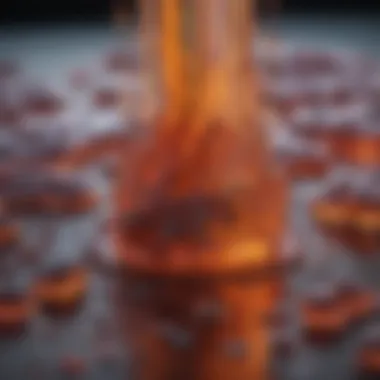
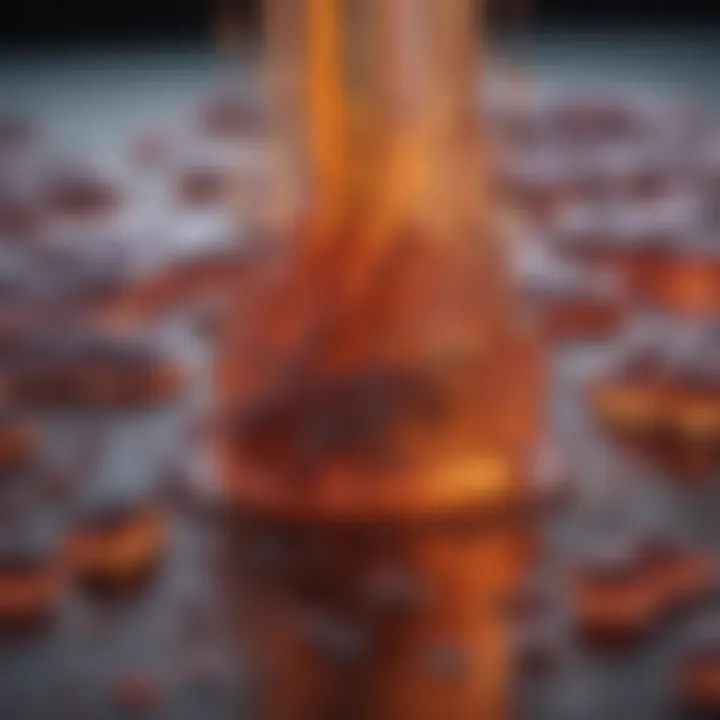
Intro
Liquid crystal thermal paint represents a remarkable intersection of materials science and practical application. The essence of this paint lies in its ability to adapt and respond to varying temperatures, thus facilitating a range of innovative uses. Understanding its properties, applications, and the underlying science is essential for anyone engaged in manufacturing, academic research, or related industries. This article aims to explore these dimensions meticulously, helping to demystify the complexities involved.
Key Concepts and Terminology
Definition of Key Terms
- Liquid Crystals: These substances exhibit properties between that of liquids and solids, allowing them to flow like liquids while maintaining some ordered structure like solids.
- Thermal Paint: A type of paint designed to control or manage heat transfer, potentially increasing energy efficiency in various applications.
- Chromatic Response: Refers to the ability of the paint to change color in response to temperature fluctuations.
Concepts Explored in the Article
- Composition and Properties: The chemical components that contribute to the unique qualities of liquid crystal thermal paint.
- Scientific Principles: Fundamental theories that explain how liquid crystals interact with thermal energy.
- Applications Across Industries: A broad look at how this paint is used in sectors like automotive, construction, and consumer electronics.
- Recent Innovations: Emerging technologies and advancements that push the boundaries further.
- Future Trends and Challenges: Speculations on the evolving landscape of liquid crystal thermal paint, along with potential obstacles.
Findings and Discussion
Main Findings
Research shows that the integration of liquid crystal technology in thermal paints can drastically improve energy efficiency. The ability of these paints to reflect or absorb heat contributes significantly to temperature regulation in various settings. For instance, buildings utilizing this paint can lower air conditioning costs, while vehicles can maintain optimal engine temperatures more effectively.
Potential Areas for Future Research
Future studies may delve into several crucial areas.
- Optimization of Formulations: Enhancing the chemical composition for better durability and performance.
- Scaling Production: Address the challenges of manufacturing liquid crystal thermal paint at a larger scale while maintaining quality.
- Environmental Impact: Investigating sustainable practices surrounding the life cycle of these paints.
Liquid crystal thermal paint is a fertile ground for research and innovation. The continuous exploration of its capabilities and applications supports a push towards smarter materials in modern industry.
"The future of liquid crystal technology is not only promising; it holds the potential to revolutionize how materials interact with their environment."
Maintaining this awareness of developments contributes to a comprehensive understanding of liquid crystals in thermal applications, highlighting their significance in contemporary technology.
Preface to Liquid Crystals
The discussion of liquid crystals serves as a fundamental cornerstone in understanding liquid crystal thermal paint. Liquid crystals are unique states of matter that exhibit properties between those of conventional liquids and solid crystals. This topic is not just a mere technicality; it lays the groundwork for grasping how liquid crystal thermal paints operate and their applications in various industries.
Definition and Characteristics
Liquid crystals are phases of matter that possess characteristics of both liquids and solids. When subjected to certain temperatures, these substances change their molecular alignment, resulting in distinct optical properties. This responsiveness to temperature changes is particularly crucial in thermal paints, as it allows them to alter their color with temperature variations. The definition of liquid crystals includes several key characteristics:
- Anisotropy: This refers to the directional dependence of physical properties, such as refractive index and conductivity, which can change based on the alignment of molecules.
- Viscosity: Liquid crystals maintain a level of fluidity akin to liquids but exhibit viscosity that can vary with temperature, influencing how they form coatings.
- Thermal Responsiveness: This characteristic is the most significant for thermal paints, showcasing how liquid crystal materials react to heat by changing color.
Historical Context
The study of liquid crystals dates back to the late 19th century. Friedrich Reinitzer, an Austrian botanist, first described these phases in 1888. His observations of the coloration changes in cholesteryl benzoate led to the identification of these unique materials. Such foundational work prompted subsequent exploration that discovered various types of liquid crystals and their potential applications, particularly in display technologies. Over the decades, advancements in material science have propelled liquid crystal research, leading to innovations utilized in today’s thermal paints.
Types of Liquid Crystals
Liquid crystals can be categorized into several types based on their molecular structure and behavior:
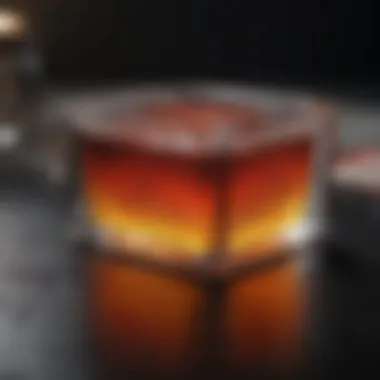
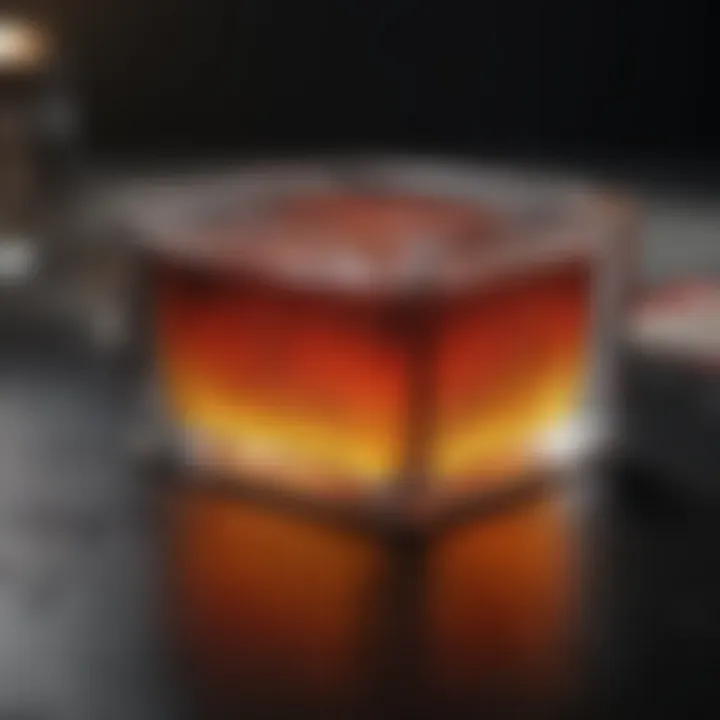
- Thermotropic Liquid Crystals: These respond to temperature changes. When heated or cooled, their molecular arrangement can change, which is vital for thermal paint applications.
- Lyotropic Liquid Crystals: These require a solvent to form a liquid crystalline phase. This property is useful in specific applications where solvents play a role in the final product.
- Smectic and Nematic Phases: These are two primary categories within thermotropic liquid crystals. Smectic phases have a layered structure, while nematic phases lack the order of the smectic but retain orientation among molecules.
Through understanding these various types, one can appreciate how liquid crystal thermal paint derives its functionality from these unique characteristics. Given their ability to react dynamically to environmental conditions, liquid crystals shape the development of innovative materials that can adapt to real-world applications.
Overview of Thermal Paints
Understanding the realm of thermal paints is vital to grasp the innovations presented by liquid crystal thermal paint. These paints have unique characteristics that set them apart from standard coatings. They not only provide aesthetic value but also play a crucial role in temperature regulation and energy efficiency. In industrial and commercial applications, thermal paints can lead to significant energy savings by reflecting or absorbing heat depending on the formulation.
What Defines Thermal Paint?
Thermal paint is specially designed to control the temperature of surfaces using specific thermal properties. These paints have the ability to either absorb or reflect heat. This feature makes thermal paints particularly useful in various environments. For instance, they can keep buildings cooler in hot climates or retain heat in colder regions. The mechanism behind this thermal responsiveness is anchored in the formulation, which often includes materials that interact with thermal radiation.
Composition of Thermal Paints
The composition of thermal paints generally includes a mix of polymers, pigments, and additives that contribute to their thermal properties. Common components include:
- Thermal Insulating Agents: These materials help to minimize heat transfer, enhancing the efficiency of the paint.
- Reflective Pigments: Often made from metals like aluminum, these pigments help reflect sunlight away, reducing heat absorption.
- Binders: These materials ensure that all components mix well and adhere to surfaces, providing longevity and durability.
Different manufacturers may have unique formulations, which can lead to varying degrees of thermal performance. Understanding the precise components is essential for selection based on specific needs.
Comparative Analysis with Traditional Paints
When compared to traditional paints, thermal paints offer enhanced functionality. Traditional paints primarily serve decorative purposes and lack significant thermal management features. In contrast, thermal paints:
- Enhance Energy Efficiency: They contribute to lowering energy costs due to their ability to regulate temperatures effectively.
- Provide Longer Lifespan: The durability of thermal paints often surpasses that of standard options, making them a wise investment in the long term.
- Allow for Innovation in Design: With advancements in thermal paint technology, architects and designers have a broader range of options to create energy-efficient and visually appealing spaces.
Understanding thermal paints provides a strong foundation to explore the more specialized characteristics of liquid crystal thermal paint. Their applications span multiple industries, benefiting energy management and aesthetic value.
Properties of Liquid Crystal Thermal Paint
Liquid crystal thermal paint presents an array of unique properties that distinguish it from traditional paint types. These properties are crucial for understanding its applications and the innovations that emerge from it. The exploration of these properties allows industries to unlock new possibilities while offering solutions to traditional challenges such as thermal management and aesthetic appeal. This section will cover its thermal responsiveness, color transition mechanisms, and its durability along with environmental resistance.
Thermal Responsiveness
The thermal responsiveness of liquid crystal thermal paint is one of its most significant attributes. This property allows the paint to change its appearance based on temperature variations. The underlying principle relies on the molecular behavior of liquid crystals, which can transition between different states based on thermal energy. In practical applications, this means the paint can act almost like a thermometer, providing a visual cue regarding temperature changes.
The effectiveness of this responsiveness can lead to enhanced safety in environments where heat management is critical. For instance, in automobiles, the paint can indicate overheating components, allowing for preventive measures before significant damage occurs.
Color Transition Mechanisms
Color transition mechanisms in liquid crystal thermal paint are fascinating. These mechanisms are fundamentally based on how the liquid crystal molecules orient themselves at different temperatures. When heat is applied, the arrangement of these molecules alters, reflecting different wavelengths of light and consequently changing the color perceived by the human eye.
This characteristic has substantial implications. In architectural applications, buildings coated with this type of paint can result in energy savings by reflecting sunlight in warmer conditions and absorbing heat in cooler conditions. This adaptability can lead not only to aesthetic appeal but also to functional benefits in energy efficiency.
"The visual shift in color can be a powerful tool in design and function, making spaces not only more beautiful but also more livable."
Durability and Environmental Resistance
When considering any paint, durability and environmental resistance are vital factors. Liquid crystal thermal paint is designed to withstand a variety of challenging conditions, including UV exposure, moisture, and temperature fluctuations. Its unique chemical composition enhances its ability to resist degradation over time, ensuring that the vivid colors remain intact and the thermal properties continue to function effectively.


In environments with extreme weather, such as in aerospace or outdoor installations, this resilience pays dividends. Customers can be assured that the investment in such paint will endure, reducing the need for frequent maintenance or repurchasing. Thus, the durability of liquid crystal thermal paint plays a pivotal role in expanding its market viability and desirability across various sectors.
Applications of Liquid Crystal Thermal Paint
Liquid crystal thermal paint has emerged as a groundbreaking technology across multiple industries. Its unique ability to change color based on temperature variations opens new possibilities. The applications of this innovative paint are vast and varied, demonstrating potential benefits not only in commercial sectors but also in enhancing efficiency and safety. This section examines the key areas where liquid crystal thermal paint finds practical use in today's world.
Automotive Industry
In the automotive industry, liquid crystal thermal paint can provide significant advantages. This technology can be integrated into car bodies to monitor temperature changes. For example, vehicles may experience overheating in certain components. By applying this paint, manufacturers can indicate heat levels visually. This capability may help in preventing mechanical failures. Moreover, using color changes allows drivers to make informed decisions about their vehicle's health.
Aerospace Applications
Aerospace applications for liquid crystal thermal paint are both innovative and critical. Aircraft experience extreme temperatures during flight. The use of this paint can provide real-time feedback on the thermal state of various components. This knowledge is crucial for ensuring safety and reliability. Engineers can apply this technology to wings, fuselage, and engine parts. It acts as an early warning system for potential overheating or malfunction. This implementation could lead to better maintenance protocols and increased safety for passengers.
Architectural Use
Architects are increasingly exploring liquid crystal thermal paint to enhance building designs. In this context, it can play a vital role in energy efficiency. By using these paints on external surfaces, buildings can react dynamically to temperature changes. For instance, during hot weather, the paint might change color to reflect more sunlight, reducing cooling costs. Conversely, in colder climates, it can absorb heat. This adaptive feature contributes to sustainability and energy savings.
Consumer Electronics
In the realm of consumer electronics, liquid crystal thermal paint can serve multiple functions. Devices that generate heat, such as laptops and smartphones, can benefit from this technology. By incorporating this paint, manufacturers can provide users a thermal indicator for device performance. Users can rely on visual cues to determine if the device is functioning within safe temperature ranges. This innovation can prolong the hardware's lifespan and improve user safety by preventing overheating incidents.
"Liquid crystal thermal paint represents a fusion of aesthetics and technology. It not only enhances the visual appeal but also provides functional benefits across various applications."
In summary, the applications of liquid crystal thermal paint are noteworthy and expanding. From automobiles to consumer electronics, its potential is being realized. As technology advances, we can expect more industries to adopt its use, leading to greater innovations and improvements in safety and efficiency.
Scientific Principles of Liquid Crystal Thermal Paint
Understanding the scientific principles of liquid crystal thermal paint is pivotal in appreciating its innovative capabilities and diverse applications. This section unfolds the fundamental aspects that guide the material's functionality. Key components include the thermodynamic properties of liquid crystals, the nature of phase transitions, and the implications of molecular structure.
Thermodynamics of Liquid Crystals
Thermodynamics plays a central role in the behavior of liquid crystals. These materials exist between the solid and liquid states, exhibiting unique thermal properties. When heated, liquid crystals can transition through various phases, each defined by specific molecular arrangements. The thermodynamic assessments of these transitions inform how thermal paint responds to temperature changes.
This responsiveness is essential in applications like energy efficient buildings and automobiles where heat management is crucial. Liquid crystal thermal paints can alter their visual properties based on temperature, thus providing not just aesthetic appeal but functional benefits as well.
Phase Transitions in Liquid Crystals
Phase transitions are intrinsic to the utility of liquid crystal thermal paint. Liquid crystals can significantly change their alignment and structure based on temperature, transitioning from a nematic to a smectic phase, for example. This change influences color and light transmission properties, making these materials suitable for adaptive surfaces.
Moreover, understanding these transitions helps researchers innovate on stability and efficiency, pushing the boundaries of application in various fields such as aerospace and automotive industries. The challenges, however, lie in ensuring consistency during these transitions, which can directly impact durability and performance.
Molecular Structure Implications
The molecular structure of liquid crystals is foundational to their unique thermal painting capabilities. The arrangement of molecules affects how they respond to thermal changes, and thus, their ability to switch colors and properties in thermal applications. Specifically, the isotropic and anisotropic characteristics govern their behavior when subjected to different temperature ranges.
Key benefits lie in the refinement of molecular design to quicken response times and enhance the range of dynamic color changes. This has significant implications for smart materials and surfaces that require real-time feedback mechanisms regarding environmental conditions.
"The studied interplay between molecular orientation, thermal state, and mass transport yields a comprehensive understanding of liquid crystal thermal paint properties."
In summary, these scientific principles underpin the extensive potential of liquid crystal thermal paint, positioning it at the forefront of thermal management innovations. Understanding these elements is not merely academic; they are essential for future advancements and commercial success.
Innovations in Liquid Crystal Thermal Paint Technology
The field of liquid crystal thermal paint is on the cusp of remarkable transformation. Innovations in this area are vast and significant, reshaping how industries perceive and utilize thermal painting. Advancements in formulation and smart paint techniques stand out as critical components driving these changes. The importance of these innovations rests not only on improved performance but also on their ability to align with modern environmental standards and market demands.
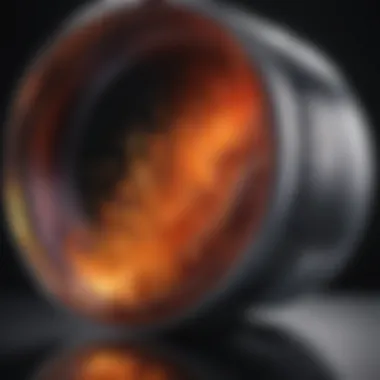

Recent Advancements in Formulation
In recent years, considerable research has focused on enhancing the formulation of liquid crystal thermal paints. These advances aim to improve thermal responsiveness and color transition capabilities. The formulations now often incorporate nanomaterials to enhance thermal conductivity and overall durability. For example, graphene and carbon nanotubes have become popular additives, significantly improving the efficiency of thermal regulation.
Another key area of advancement is the development of environmentally friendly solvents and binders. Manufacturers are increasingly prioritizing sustainability by reducing toxic components in paint formulations. As a result, new, safer chemical compositions are emerging, offering better performance without compromising user safety or ecological integrity. This shift aligns with the growing push for green chemistry in all sectors, leading to paints that not only perform well but also meet environmental regulations.
Smart Paint Techniques
Smart paint techniques represent a pioneering leap in the functionality of liquid crystal thermal paints. These techniques integrate digital technologies to enable real-time monitoring and adaptation of paint properties. One such innovation is the incorporation of sensors within the paint layer. These sensors can detect temperature changes and adjust the paint's thermal properties accordingly.
Furthermore, the advent of programmable thermal paints allows for user-defined color and thermal characteristics. This means that with the right input, the paint can change hues or improve thermal insulation based on the surrounding conditions.
Smart paints provide various applications, extending beyond aesthetic purposes. They can improve energy efficiency in buildings by regulating heat absorption and loss. Some initiatives even explore the use of such paints in smart homes, where climate control can be automatically adjusted based on paint feedback mechanisms.
"Innovative formulations and smart techniques are not only enhancing thermal paint performance but also revolutionizing its applications across industries."
Market Trends and Future Prospects
The exploration of liquid crystal thermal paint provides significant insights into the present and future market for this innovative product. Understanding market trends and future prospects is crucial for stakeholders, allowing them to navigate effectively through emerging opportunities and challenges. The expansion of this sector is propelled by ongoing research, advancements in technology, and a growing awareness of efficient materials across various applications.
Current Market Dynamics
The current landscape of the liquid crystal thermal paint market is marked by increasing demand in industries such as automotive, aerospace, and consumer electronics. Companies are investing in research and development to enhance the properties of these paints, thereby expanding their applicability. Market dynamics indicate a strong inclination towards sustainable and smart materials. For instance, as environmental regulations become stricter, the focus shifts to eco-friendly alternatives that do not compromise performance. Moreover, the rise of smart technology adoption in everyday products propels liquid crystal thermal paint to the forefront of innovation. Several manufacturers report a positive growth trend, reflecting a heightened interest among consumers and industries alike.
Challenges Facing Adoption
Despite the promising outlook for liquid crystal thermal paints, challenges remain. High production costs can deter manufacturers from fully engaging in this market. Liquid crystal thermal paints often require specialized processing techniques and equipment, leading to increased expenses. Furthermore, there is a lack of widespread knowledge regarding the use and advantages of this technology. Many potential users may hesitate to invest due to insufficient data on long-term performance and reliability. Educating stakeholders about the capabilities and benefits of liquid crystal thermal paint will be essential to overcoming these barriers.
Future Innovations in Thermal Paints
Looking ahead, future innovations in thermal paints are likely to focus on enhancing functionalities and reducing costs. Researchers are exploring novel formulations that integrate liquid crystals with nanotechnology for improved thermal regulation. Additionally, advancements in smart paint techniques, such as self-healing properties, are potential game-changers. Another area of innovation involves developing paint systems that can change color based on temperature variation or external stimuli. These developments promise to further establish liquid crystal thermal paint as a vital component in various sectors, underscoring its potential impact on design and functionality.
"Innovation in thermal paints is not just about improving aesthetics, but also about integrating technology to enhance performance continuously."
The Ends and Implications
The discussion around liquid crystal thermal paint is not just a technical analysis but also a roadmap for future opportunities. This innovative material blends art and science, presenting unique properties that serve various industries. Understanding its potential implications is essential for stakeholders.
Summary of Findings
In summary, liquid crystal thermal paint possesses remarkable features that transcend conventional thermal paints. The paint reacts to temperature changes, allowing for color transitions that can be utilized in a variety of applications. Key findings include:
- Thermal Responsiveness: The paint exhibits significant temperature changes, which allows it to be used in settings where heat regulation matters.
- Diverse Applications: Fields such as automotive, aerospace, and architecture stand to benefit from this technology. Each sector can exploit the unique properties for functional enhancements or aesthetic improvements.
- Environmental Resilience: Liquid crystal thermal paints demonstrate durability in various environmental conditions, ensuring long-lasting applications that traditional paints may not provide.
These factors solidify the position of liquid crystal thermal paint in the spectrum of advanced materials.
Impacts on Related Fields
The innovation surrounding liquid crystal thermal paint offers implications that extend beyond its immediate applications. Some of these impacts include:
- Advancements in Energy Efficiency: In the construction sector, the paint can contribute to energy savings by regulating temperature and reducing heating and cooling costs.
- Automotive Design Integration: In automotive design, the ability to change color could lead to more personalized and functional vehicle designs.
- Expansion of Smart Technologies: The integration of smart coatings into consumer electronics opens avenues for enhanced user interfaces and feedback systems.
The ripple effect of adopting liquid crystal thermal paint can change how industries approach thermal management and aesthetic customizations.
The future of liquid crystal thermal paint is bright, driven by a blend of innovation, practicality, and vast industry applications.







